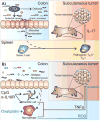From promotion to management: the wide impact of bacteria on cancer and its treatment
- PMID: 24752750
- PMCID: PMC4179290
- DOI: 10.1002/bies.201400015
From promotion to management: the wide impact of bacteria on cancer and its treatment
Abstract
In humans, the intestine is the major reservoir of microbes. Although the intestinal microbial community exists in a state of homeostasis called eubiosis, environmental and genetics factors can lead to microbial perturbation or dysbiosis, a state associated with various pathologies including inflammatory bowel diseases (IBD) and colorectal cancer (CRC). Dysbiotic microbiota is thought to contribute to the initiation and progression of CRC. At the opposite end of the spectrum, two recently published studies in Science reveal that the microbiota is essential for chemotherapeutic drug efficacy, suggesting a beneficial microbial function in cancer management. The dichotomy between the beneficial and detrimental roles of the microbiota during cancer initiation, progression, and treatment emphasize the interwoven relationship between bacteria and cancer. Moreover, these findings suggest that the microbiota could be considered as a therapeutic target, not only at the level of cancer prevention, but also during management, i.e. by enhancing the efficacy of chemotherapeutics.
Keywords: cancer; chemotherapy; dysbiosis; intestinal microbiota; therapeutic efficacy.
© 2014 WILEY Periodicals, Inc.
Figures



Comment on
-
Commensal bacteria control cancer response to therapy by modulating the tumor microenvironment.Science. 2013 Nov 22;342(6161):967-70. doi: 10.1126/science.1240527. Science. 2013. PMID: 24264989 Free PMC article.
References
-
- Wainwright M, Lederberg J, Lederberg J. History of microbiology. Enc Microbiol. 1992;2:419–37.
-
- Bernardes N, Chakrabarty AM, Fialho AM. Engineering of bacterial strains and their products for cancer therapy. Appl Microbiol Biotechnol. 2013;97:5189–99. - PubMed
-
- Sommer F, Bäckhed F. The gut microbiota--masters of host development and physiology. Nat Rev Microbiol. 2013;11:227–38. - PubMed
-
- Aidy El S, Van den Abbeele P, Van de Wiele T, Louis P, et al. Intestinal colonization: how key microbial players become established in this dynamic process: microbial metabolic activities and the interplay between the host and microbes. BioEssays. 2013;35:913–23. - PubMed
Publication types
MeSH terms
Grants and funding
LinkOut - more resources
Full Text Sources
Other Literature Sources

